

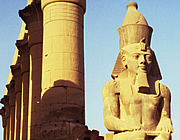
The magnificent temples of Luxor and Karnak are best seen early in the morning before the bulk of the tourists arrive, or late in the day when they have left.
The impressive Temple of Hathor at Dendera is very well-preserved, atmospherically set on the edge of the desert some way north of Luxor.
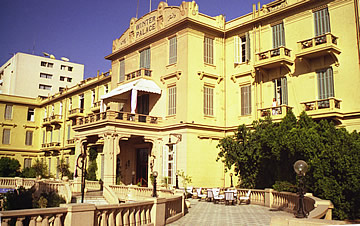
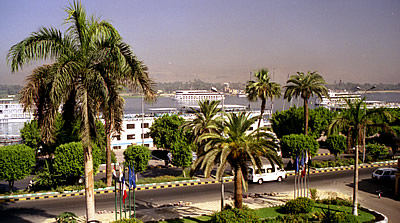
On our first visit to Luxor we stayed in the Sheraton, which was fine, and had a nice outdoor barbecue and we had a room with a Nile view - essential!
On our second visit we stayed at The Old Winter Palace, which is a wonderful much more atmospheric place: high-ceilinged rooms, sweeping staircases and an enormous restaurant. We loved our room, with a view of the Nile and across to the Necropolis of Thebes - a fine place to watch the sun setting over the desert.
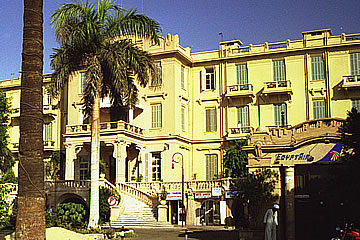
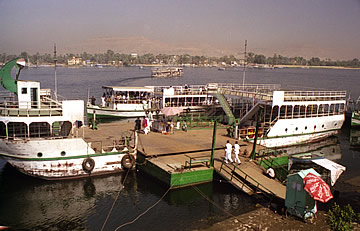
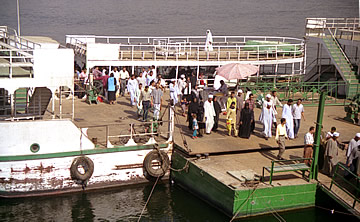
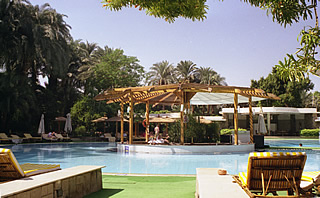
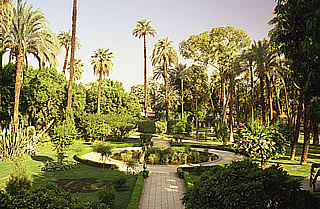
Breakfasts in the hotel were great - particularly the waffles. But having tried the "French" restaurant we couldn't really recommend it - overpriced and poor wine choice.
When we go back, however, we shall certainly stay here again if we can!
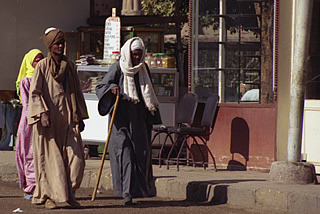
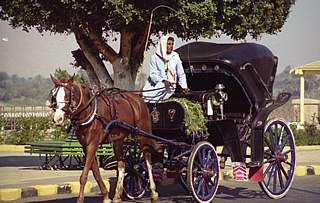
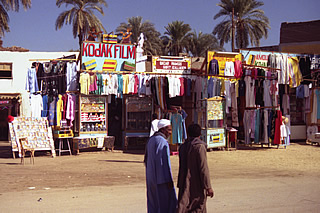
We got into the habit of getting up very early, spending the morning visiting sites, then returning for lunch and relaxation in the afternoon in the shade by the pool - a most pleasant way to spend time.
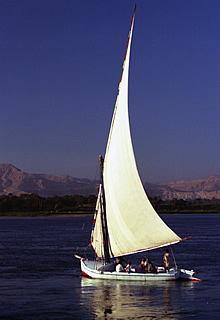
Later we'd visit the bazaars and barter for sandals, or galabias, or just wander around, down to the People's Ferry perhaps, and watch people go about their daily lives.
We followed a recommendation to visit the museum at Luxor and found it excellent. It is well organised and well lit with some wonderful artefacts. Highlights were a beautiful statue of Tuthmosis III, several Hatshepsut-related items - a wall painting depicting her as consort to Tuthmosis II and items from Deir el Bahri - and 24 statues found in 1989 at Luxor temple, especially the red granite Amenhotep III.
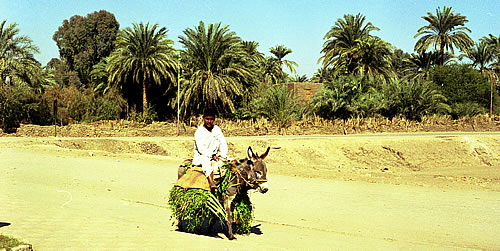
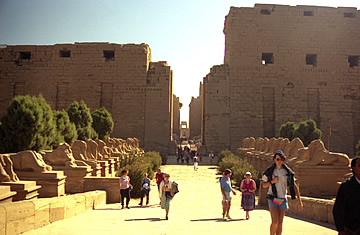
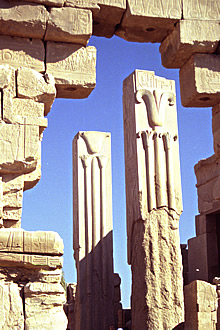
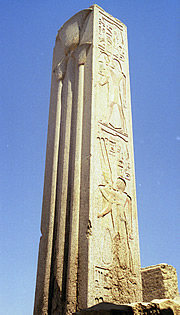
The Temple of Karnak is a fabulous, fascinating place which takes some time to explore. We found it was walkable from the Old Winter Palace but I wouldn't recommend it in the heat of the day or from the other side of town!
There is an awful lot to see here and a good guide or guide book is essential if you want to learn more than superficial history. But there is much to be said for simply wandering the ruins, as early or late in the day as possible, and simply taking in the atmosphere and colossal achievements of the builders.
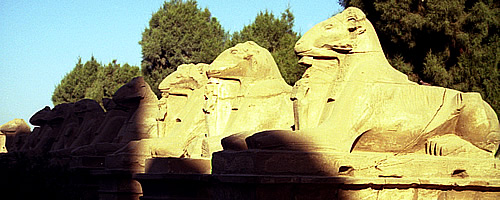
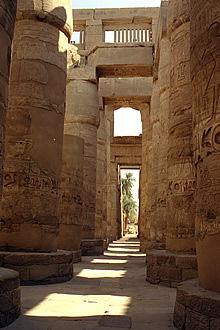
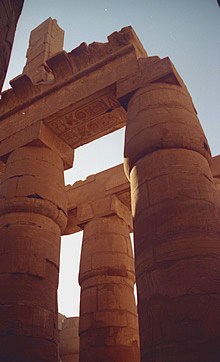
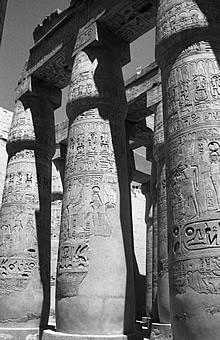
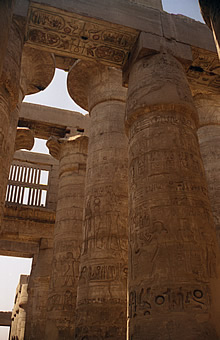
Dedicated to the Theban triad of Amun, Mut and Khons the complex covers 200 acres and its many temples were constructed over a long period of time, stretching from the Middle Kingdom (2000BC) to the time of Ptolemy Auletes (80-51BC). The largest and most important is the Temple of Amun-Ra - the largest in the world.
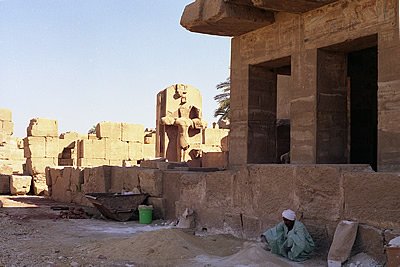
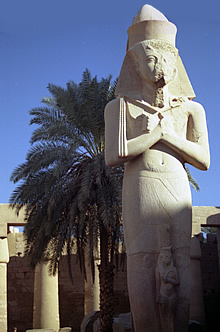
The temple is oriented roughly NW-SE with the main entrance on the NW side. Here the approach to the temple - from what was once a quay on the Nile - is lined with ram-headed sphinxes leading to the first pylon.
Although the sphinxes date from Ramses II, the pylon was constructed in the XXV (Ethiopian) Dynasty. It is 113m wide, 43m high and 13m thick - a massive structure and nearly twice the size of the entrance pylon at the Temple of Luxor.1 Through the first pylon is the Great Court - the avenue of ram-headed sphinxes once continued through here.
SW from the Great Court is the small temple of Ramses III. The SE side of the court is formed by the second pylon on the SW end of which is a famous biblical scene of the defeat of Rehoboam, son of Solomon, by the Egyptian pharaoh Sheshank I.
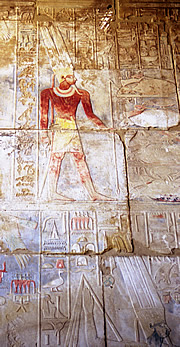
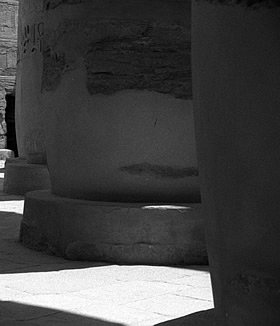
Through the second pylon is the magnificent Hypostyle Hall - the largest chamber of any temple in the world: 54000 square feet containing 134 immense columns.
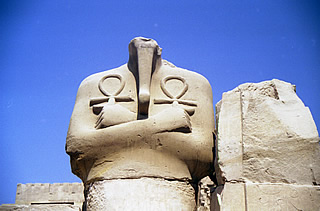
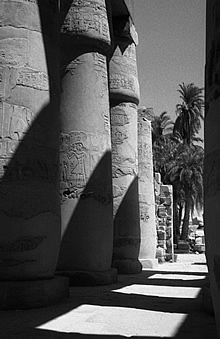
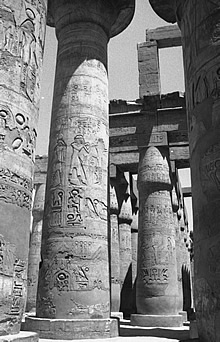
The Great Hypostyle Hall is truly spectacular, it is almost impossible to take in the scale of the building, one of the finest sites in Egypt.
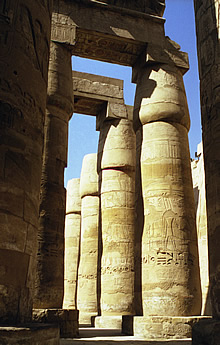
The hall has a high central aisle along the NW-SE axis with 6 huge campaniform open papyrus columns lining each side, each around 23m high and 3.5m in diameter.
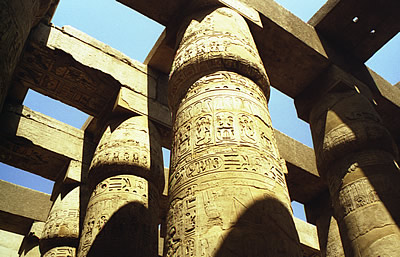
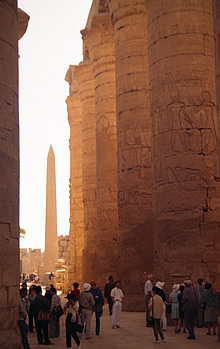
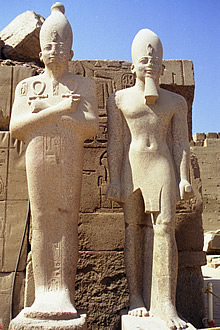
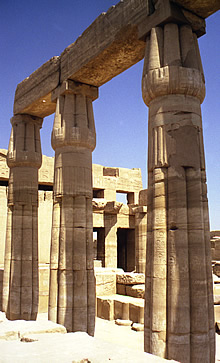
Beyond these the hall is a forest of closed lotus bud columns on both sides, strictly regimented in rows and lower in height than the central aisle.
Exiting the Great Hypostyle Hall through the Third Pylon the small Court of the Cachette is on the SW side - in the early 20th century several thousand bronze statues and 800 stone statues were excavated here.1
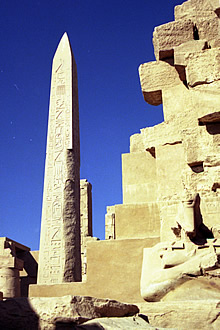
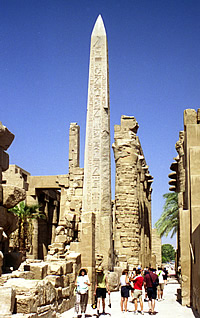
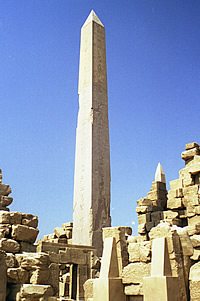
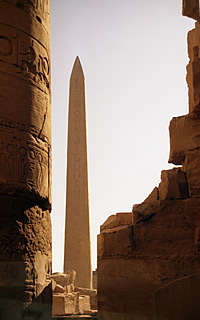
Between the third pylon of Amenhotep III and the fourth pylon of Tuthmosis I there were once two pairs of obelisks erected by Tuthmosis I and Tuthmosis II - only one of the pair of Tuthmosis I remains standing.
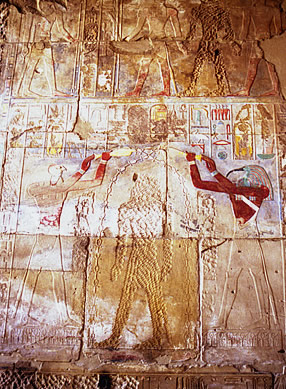
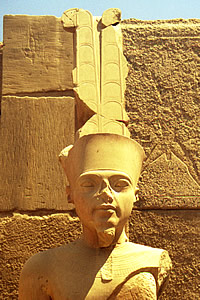
Beyond the fourth pylon are the obelisks of Queen Hatshepsut. Only one remains standing, the other fallen and in pieces, but both would originally have been capped with electrum - an alloy of gold and silver - so that they would have been visible from afar, reflecting the sun.
The upright obelisk is 30m high and is the largest in Egypt. On its base an inscription tells of the origin of the obelisks in the quarries of Aswan and how they were prepared and transported to Luxor in the sixteenth year of the queen's reign.
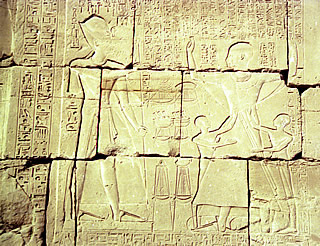
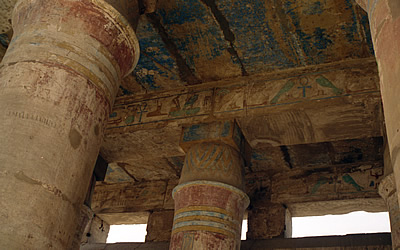
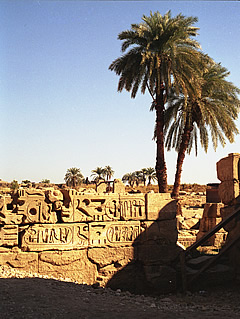
Further east through the fifth and sixth pylons and the jumbled remains of the Middle Kingdom Temple lies the Festival Temple of Tuthmosis III.
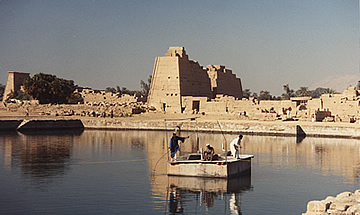
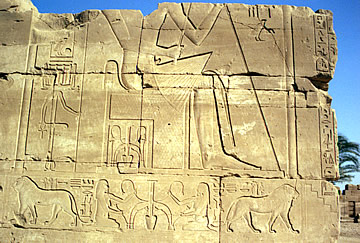
SW of these structures the Sacred Lake, created by Tuthmosis III, was used for ritual purposes by the priests of the temple.
After our first visit we knew we'd need a lot of time to see everything when we returned so second time around we made sure we arrived when the site opened.
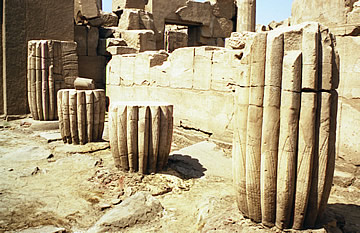
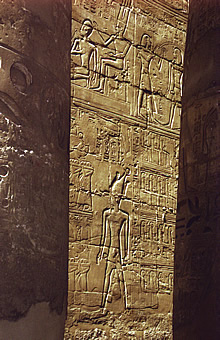
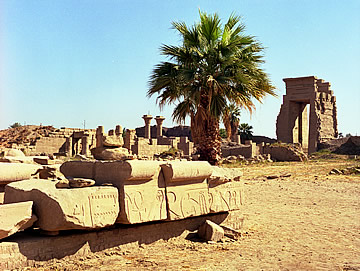
We spent another three hours exploring this magnificent temple complex and as usual taking lots of photographs.
It was very hot by the time we left so we took a horse-drawn carriage back to the Old Winter Palace - highly recommended. The horse looked really tough but it was either cunning or lazy as it regularly slowed down unless "encouraged" to move faster by the driver!
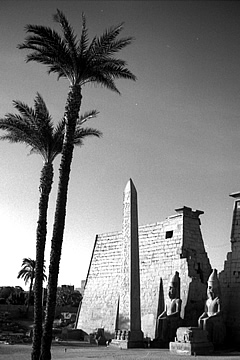
Lying alongside the Nile, and once connected to the Temple of Karnak by an avenue of human-headed sphinxes, the Temple of Luxor was constructed entirely at the end of the XVIII Dynasty and first half of the XIX Dynasty.3
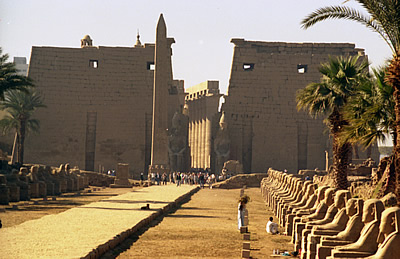
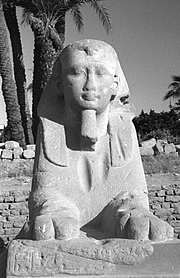
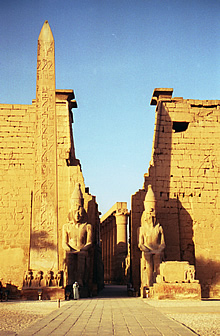
The temple was begun by Amenhotep III (1417 - 1379BC) on the site of a Middle Kingdom temple and was dedicated to the Theban Triad of Amun Ra, his wife Mut, and their son the moon god Khonsu.
It is oriented NE-SW with the main entrance on the NE side. Here a line of human-headed sphinxes, added by Nectanebo of the XXX Dynasty (380-343 BC), once stretched all the way to the Temple of Karnak.
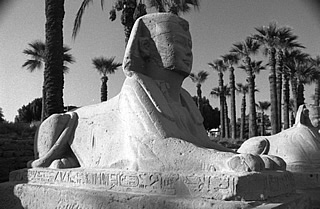
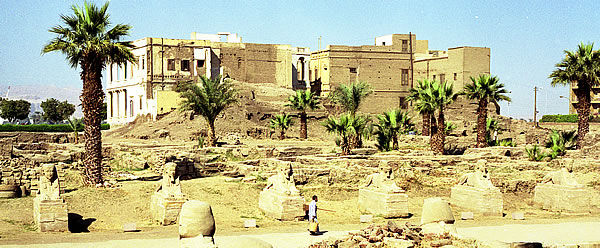
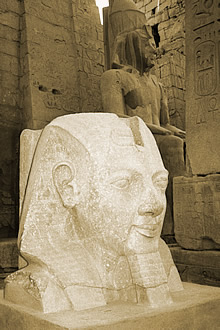
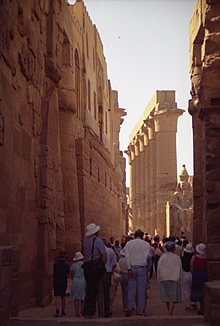
The sphinxes lead to a massive pylon which, along with the court behind it, was added by Ramses II (1304 - 1237BC).
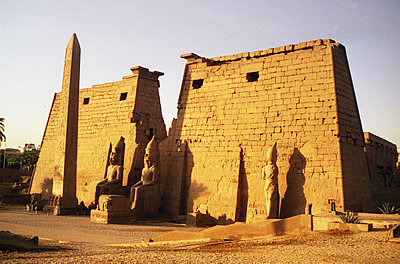
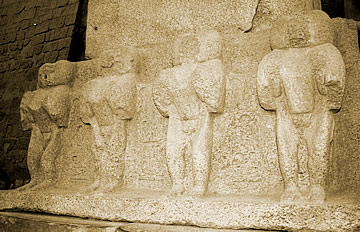
The pylon was originally fronted by six statues of Ramses II, two seated and six striding, and two obelisks. Now only the two sitting statues and one striding remain, along with one of the obelisks - the other now stands in the Place de la Concorde in Paris.
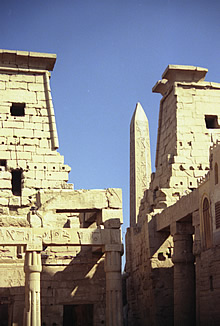
The pylon walls are carved with scenes from the Battle of Kadesh which Ramses fought against the Hittite king in the fifth year of his reign. Ramses claimed this as a massive victory, though he failed to take the city. Further battle scenes are depicted on the western temple wall through the great pylon.
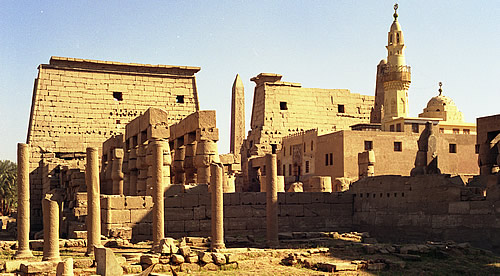
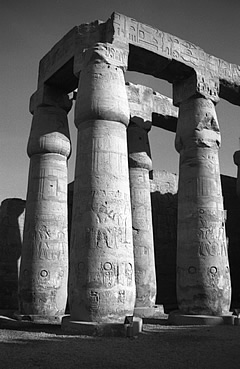
The great Court of Ramses II is reached by passing through the pylon. A chapel in the north west corner dedicated to Amun Re, Mut and Khons was built by Tuthmosis III (1504 - 1450BC) and his step-mother Hatshepsut 200 years before Ramses incorporated it into his court. Ramses' court follows the lines of this older chapel and explains why it is out of alignment with the Amenhotep-era building.
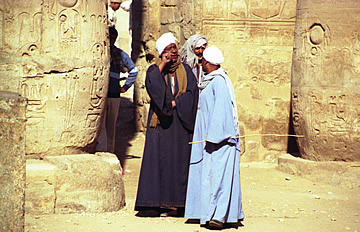
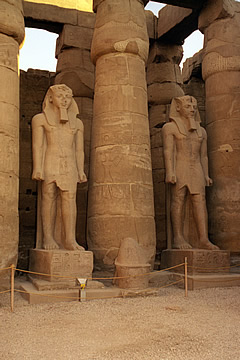
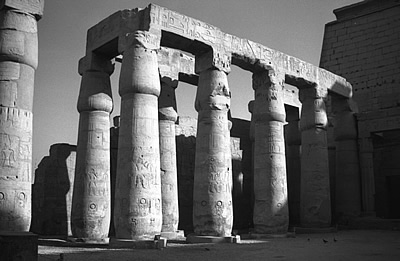
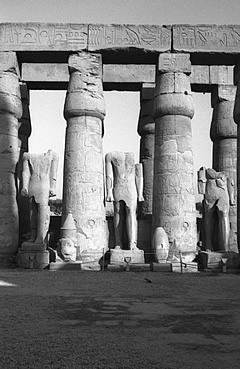
In the north west corner is a small temple built by Tuthmosis III which has three niches to house the sacred boats of Amun, Mut and Khonsu.
A mosque has also been incorporated into this court, the Mosque of Abu el Haggag who died here in 1243. Though the minaret is eleventh century, the mosque itself dates from the nineteenth.1
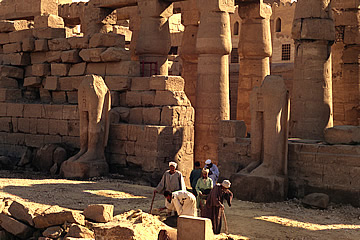
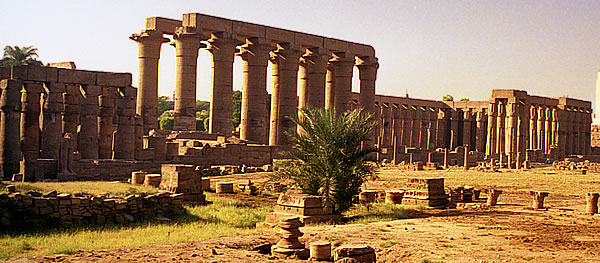
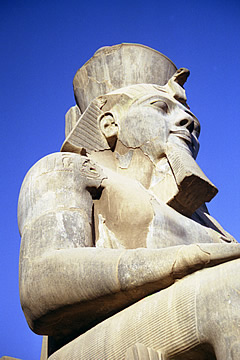
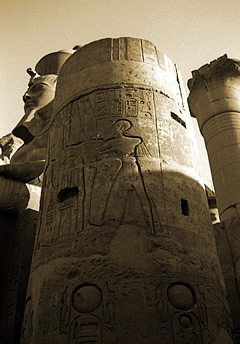

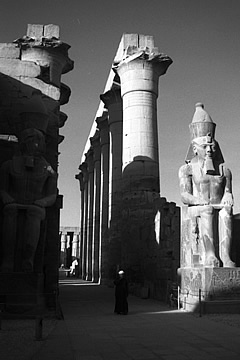
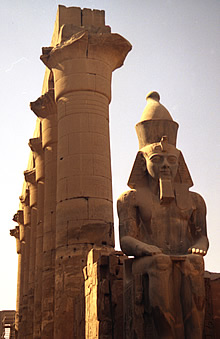
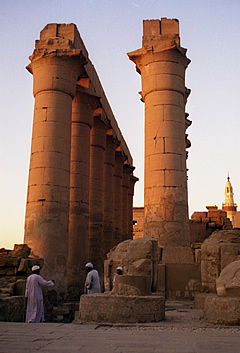
At the opposite end to the entrance to the Court of Amenhotep III through the pylon is the Great Colonnade of Amenhotep III. On each side of the colonnade is a huge black granite seated statue of Ramses II - on the right a smaller figure of his wife Nefertari stands by his right leg.
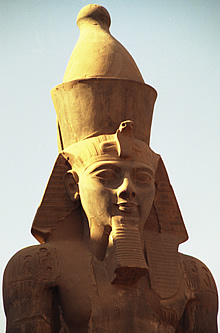
The fourteen columns of the colonnade are topped with open lotus blossom capitals, stand almost 16 metres high and lead south to the Court of Amenhotep III. They are without doubt the single most impressive feature of the temple.
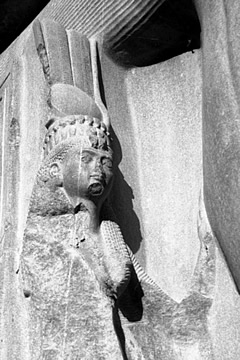
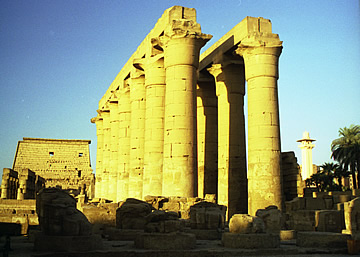
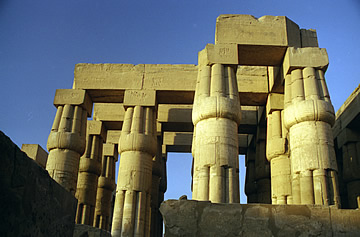
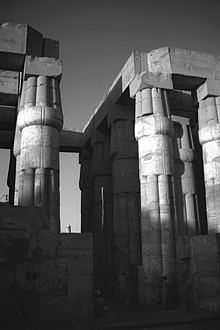
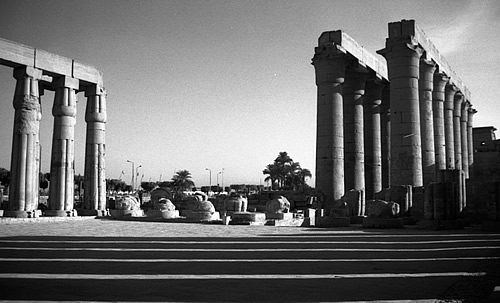
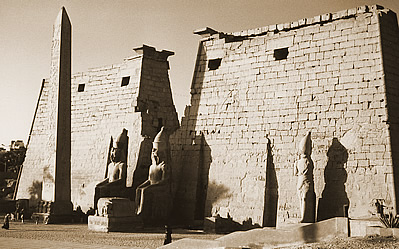
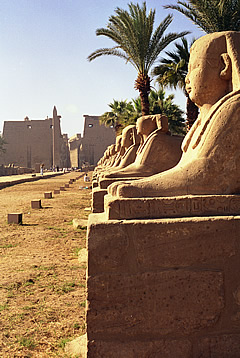
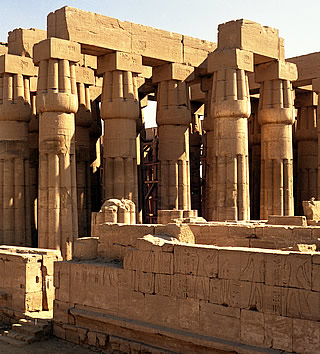
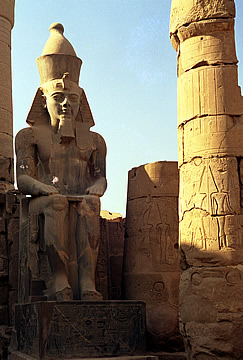
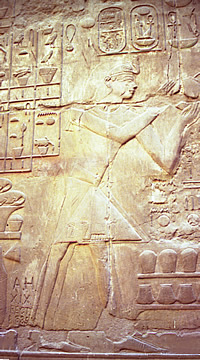
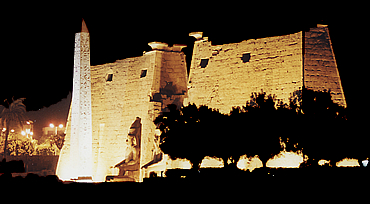
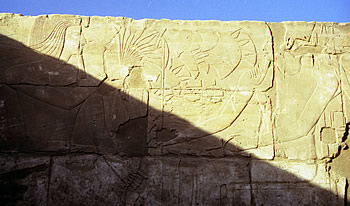

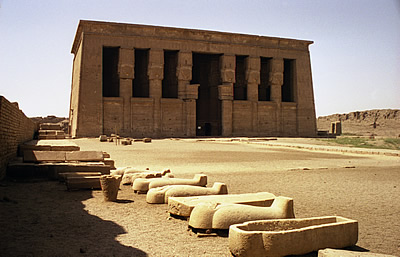
Visiting Dendera in 2000 we began from Luxor in convoy with an armed guard, the Egyptians still being very sensitive after the attacks at the Temple of Hatshepsut.
Travelling along the Nile and a canal for some way it was an experience to see local village life along the river bank: little girls in "western" dress running alongside the convoy laughing and waving, men and boys bouncing along on donkeys laden with vegetation, black-clad women striding along with loads on their heads - bundles of cloth, stacks of egg boxes - against a backdrop of reed-fenced enclosures and mud brick buildings.
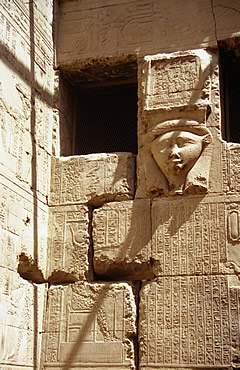
At Quena most vehicles peeled off for Hurghada on the coast and we were left alone in our air-conditioned mini-bus with our guide and one other vehicle to cross the Nile to Dendera. When we arrived we were the only visitors with our guide - we couldn't believe our luck!
The Temple of Hathor at Dendera is well-preserved and a most impressive temple site to visit, atmospherically set on the edge of the desert.
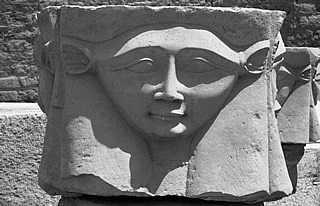
Hathor, the city goddess, has the face of a cow with distinctive ears and she can be seen adorning the temple at the tops of columns, arches, and most obviously on the facade of the temple. Although a temple would have stood at this site for many centuries the current buildings date from the second century B.C., being Ptolemaic in origin, with decorations continuing into the Roman period.
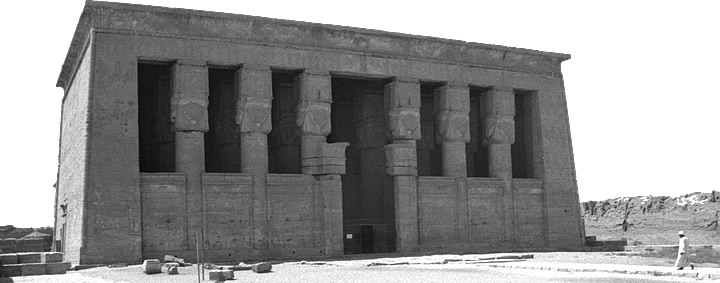
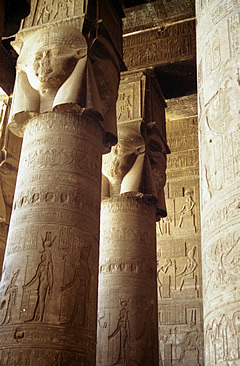
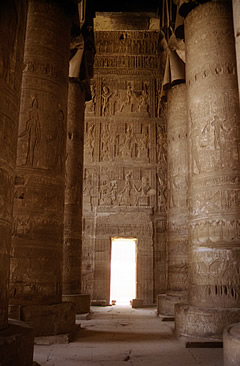
The central doorway of the facade leads to a huge hypostyle hall which is amazingly well-preserved. One of the best things about the temple is that the roof and ceilings are intact, albeit blackened by the smoke of countless Roman fires.
Regrettably many of the beautiful cow goddess faces have been hacked out by Christians but the hall is still a most impressive spectacle, every surface covered in carvings.
This huge hypostyle hall leads on to smaller halls and an inner sanctuary.
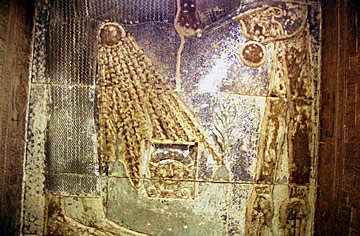
Colour is still visible in some paintings on the ceilings of astronomical subjects including winged scarabs and sun disks and a magnificent depiction of Nut, the sky goddess, who swallows the sun at the end of each day. At each dawn the sun is then reborn.
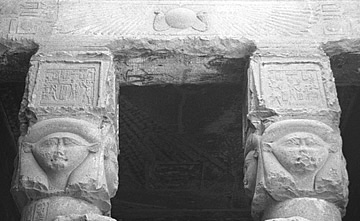
Throughout the halls numerous brown bats with translucent wings roost in the doorways.
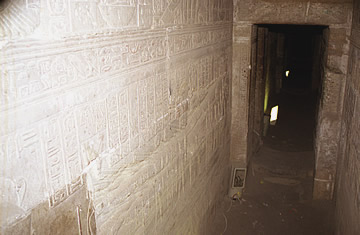
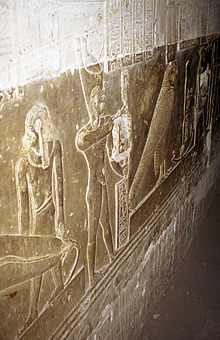
At the far end is the entrance to the crypts. I can't imagine how they accommodate large numbers of visitors but being on our own we were privileged to be able to visit the underground rooms, climbing down a rickety stair and through a narrow entrance to a passageway with wonderful inscriptions and decorations on the walls, including a beautiful Horus, the "husband" of Hathor. One of the annual festivals held in ancient times at Dendera was the journey of Hathor, in the form of a statue, up the Nile to visit Horus at the Temple of Edfu.
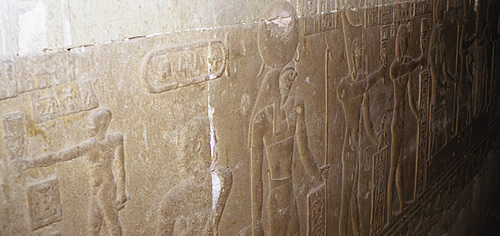
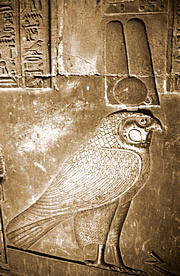
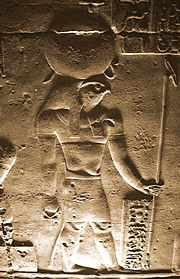
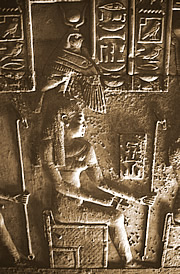
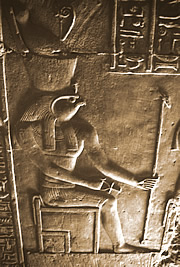
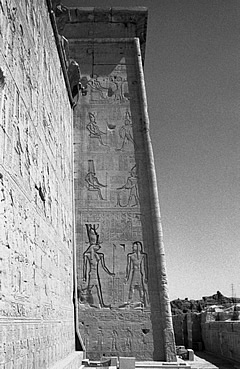
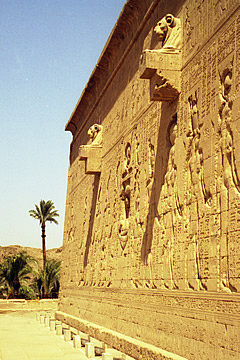
Another important annual festival involved carrying Hathor to the roof of the temple to absorb the sun's rays. We climbed the ceremonial staircase on one side of the temple which is decorated with images of the goddess being carried up to the roof, descending by a staircase on the opposite side which has images of the goddess being carried down.
On the roof there are chapels and the ceiling of one room has a copy of a marvellous unique ancient zodiac ( the original is in the Louvre).
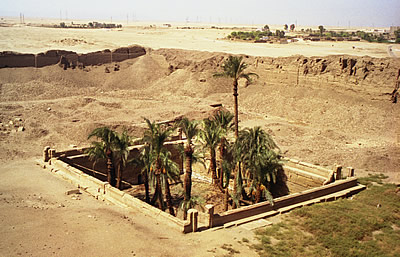
From the roof the surroundings of the temple can be seen, including "Cleopatra's Pool", actually the Sacred Lake, together with a marvellous view over the surrounding landscape.
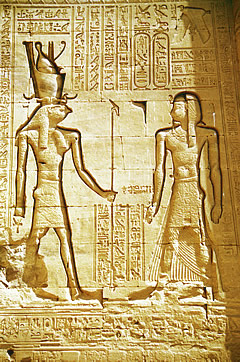
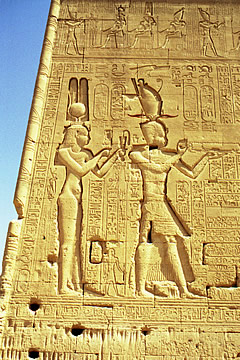
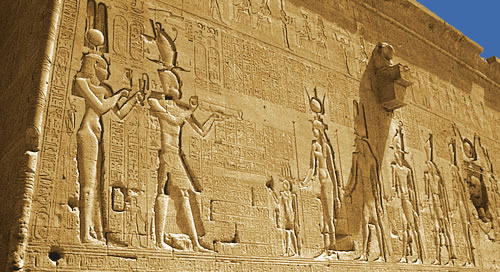
The outer faces of the temple walls bear some wonderful carved figures, including Cleopatra with her son by Julius Caesar called Caesarian on the south wall. Here can also be found the small Temple of Isis.
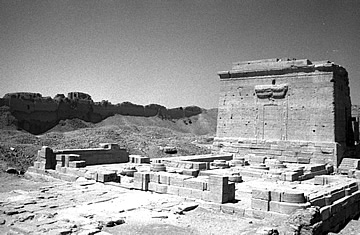
The complex has the remains of three Birth Houses (one is completely in ruins). These were important in establishing the pharaoh's relationship with the god Horus, and thus his divinity and right to rule, by a ritual association with the god's birth celebrated in the Birth House. One of the Birth Houses at Dendera shows Ptolemy born of the gods, a descendant of Horus, and therefore a true ruler of Egypt.
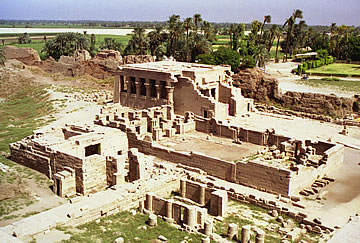
Dendera is magnificent, one of my favourite Egyptian sites and well worth the effort of travelling to see it.